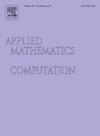Induced cycles vertex number and (1,2)-domination in cubic graphs
IF 3.4
2区 数学
Q1 MATHEMATICS, APPLIED
引用次数: 0
Abstract
A (1,2)-dominating set in a graph is a set such that every vertex outside has at least one neighbor in , and each vertex in has at least two neighbors in . The (1,2)-domination number, , is the minimum size of such a set, while is the cardinality of the largest vertex set in that induces one or more cycles. In this paper, we initiate the study of a relationship between these two concepts and discuss how establishing such a connection can contribute to solving a conjecture on the lower bound of for cubic graphs. We also establish an upper bound on for cubic graphs and characterize graphs that achieve this bound.
三次图中的诱导环顶点数和(1,2)-支配
图G中的(1,2)支配集是一个集S,使得S以外的每个顶点在S中至少有一个邻居,并且S中的每个顶点在S中至少有两个邻居。(1,2)支配数γ1,2(G)是这样一个集的最小大小,而cind(G)是G中诱导一个或多个循环的最大顶点集的基数。在本文中,我们开始研究这两个概念之间的关系,并讨论如何建立这样的联系有助于解决关于三次图的cind(G)下界的一个猜想。我们还建立了三次图的cind(G)的上界,并刻画了达到这个上界的图。
本文章由计算机程序翻译,如有差异,请以英文原文为准。
求助全文
约1分钟内获得全文
求助全文
来源期刊
CiteScore
7.90
自引率
10.00%
发文量
755
审稿时长
36 days
期刊介绍:
Applied Mathematics and Computation addresses work at the interface between applied mathematics, numerical computation, and applications of systems – oriented ideas to the physical, biological, social, and behavioral sciences, and emphasizes papers of a computational nature focusing on new algorithms, their analysis and numerical results.
In addition to presenting research papers, Applied Mathematics and Computation publishes review articles and single–topics issues.

 求助内容:
求助内容: 应助结果提醒方式:
应助结果提醒方式:


